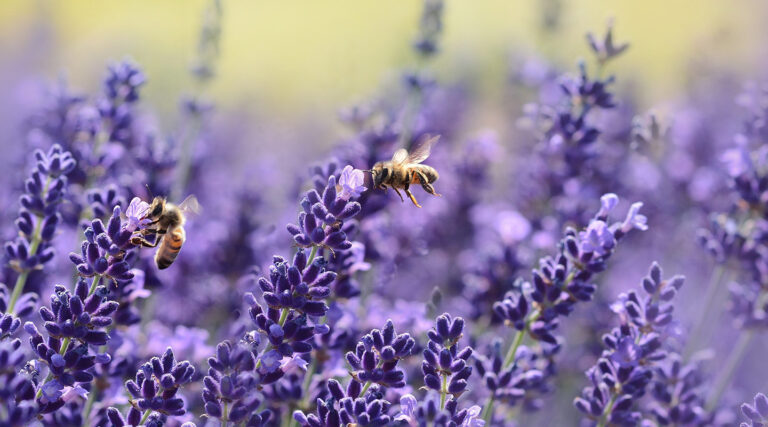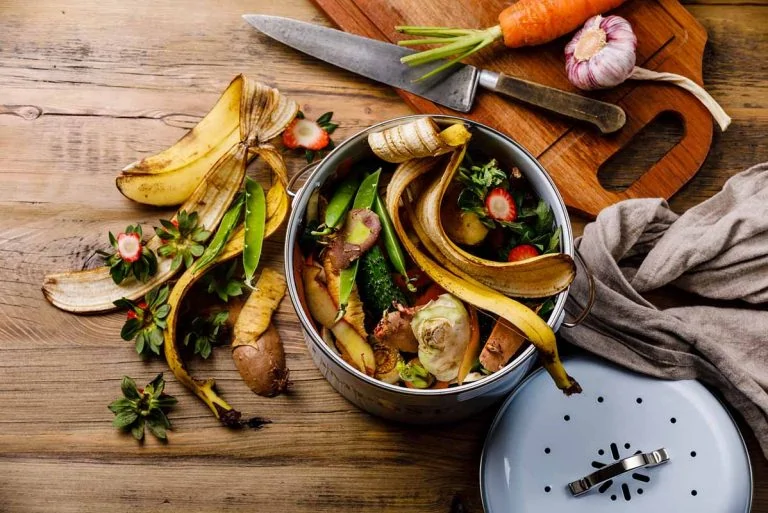In the warmer months, bees and wasps are typically not welcome guests. This could be because of the fear that they will sting us or land in our food, or just a general dislike for buzzing insects. However, despite being regarded as pests, bees and other pollinators are essential to our survival. In fact, one out of every three bites of food you eat is because of pollinators.
How? Because pollinators like bees, bats, and butterflies pollinate over 180,000 plant species and more than 1,200 crops. The first step of pollination happens when a pollen grain moves from the male part of a flower to the female part, and pollinators play a key role in this movement of pollen.
For this reason, protecting our bees has become a priority for environmentalists around the world. Harmful bee repellents that contain chemicals are not only damaging bee populations, they are also contributing to pollution. There is, however, a way to peacefully coexist with bees and pollinators without harming them: natural bee repellent.
In this guide, we’ll explore all you need to know about how effective natural bee repellent is, and how to create your own recipe at home.
Is it possible to keep bees away naturally?
Before turning to bee repellent methods, there are some key facts to know about bee behavior that can help you avoid attracting bees, whether you have an allergy or simply do not like bees buzzing around you while outside.
Ever notice that beekeepers wear white suits? This is because bees are aggressive towards dark, fuzzy objects. Be sure to wear light-colored clothing if you’re hoping to avoid bees.
You’ll also want to avoid wearing flowery scents or sweet-smelling soaps, hair products, or deodorant. These sweet smells will likely attract not only bees, but other insects to you.
The same goes for flowers in your yard – if you’re aiming to avoid bees, avoid planting sweet-smelling plants and flowers in your yard, as pollinators are attracted to them.

And why are bees so attracted to sweet scents? The short answer is sugar! Many bees feed on the nectar from flowers and plants, so the sugary beverage you’re drinking or sweet perfume you’re using will no doubt attract the attention of bees.
Bees eat nectar to feed their colony and to fuel their flight. In fact, bees can actually taste sugars: when in contact with food, their taste neurons are activated, signaling the presence of food.
If these methods of avoiding the attention of bees do not work for you, there are plenty of natural bee repellent methods that will discourage bees without harming them.
Looking to natural solutions is critical because bee populations are shrinking: pollution, disease, the misuse of chemicals, and changes in climatic patterns are all leading to shrinking and shifting pollinator populations.
We can all do our part to reduce the damage done to bee populations by opting for natural repellent methods. After all, cross-pollination helps at least 30% of the world’s crops and 90% of wild plants thrive, according to the Natural Resources Defense Council.
Do natural bee repellent methods actually work?
While some bee infestations may require professional help from a bee removal expert (not an exterminator!), in most cases, natural bee repellents are just as effective as those that utilize harmful chemicals.
Let’s explore some of the most effective substances for repelling bees.
Citronella

Citronella is one of the most effective natural bee repellents. Many insect repellent products contain citronella in the form of sprays and candles.
Citronella oil repels insects rather than killing them. Sensitive bees are deterred by strong smells, and they will particularly avoid areas infused with the scent of citronella.
You can purchase citronella oil and apply it to various areas around your yard or clothing, or light citronella candles while you’re outside to create a masking odor that bees and insects will avoid.
While citronella will not harm bees directly, it’s a super effective way to keep them from flying around certain areas of your yard or home.
Peppermint

In a similar way, the smell of peppermint will also repel bees from a certain area. The strong peppermint scent interferes with bees’ sensitive sense of smell, making this natural ingredient a great natural bee repellent.
To utilize peppermint at home, you can plant peppermint plants in your yard or dab peppermint essential oils on your body, clothing, or areas of your yard.
Cinnamon

The scent of cinnamon also encourages bees to relocate, and you most likely already have this ingredient in your home.
If a hive of honey bees has decided to settle in your yard and you’d like them to move, try sprinkling cinnamon powder around their hive for about a week.
While the smell won’t hurt them, it is strong enough that it will overpower sweet-smelling flowers in the area and the colony of bees will most likely move on.
Distilled vinegar

Distilled vinegar is another item that you most likely already have in your home! An all-natural solution for green cleaning at home, vinegar has many uses. It’s no surprise that it can also help you keep bees away from swarming your home and yard.
One of the best ways to utilize vinegar as a natural bee repellent is to create a spray: combine equal parts vinegar and water, and then spray this solution in the vicinity of the beehive or around your yard. Be sure to check whether vinegar can damage your deck, patio, or furniture, however.
You can also fill small containers with vinegar – such as recycled cans or glass jars – and place them around your patio, yard, and windowsills.
Fresh cucumber

Cucumbers are also surprisingly effective at keeping bees away. However, just laying a whole cucumber in your yard will not really help; it’s actually the cucumber peel that bees and wasps dislike. This is because bees aren’t fond of the acidity of cucumber peels.
So, placing cucumber peels around your yard or home, on window sills, or other high places where rabbits cannot reach them is a great solution to keeping bees away naturally.
You can also cut up the peels and lay them on an aluminum pie dish for an extra-effective repellent: the ensuing chemical reaction will create a scent that bees can’t stand.
DIY natural bee repellent
To create a super effective bee repellent, you can also concoct your own solution at home. Various recipes combine these bee repelling ingredients that won’t harm people or wildlife in your yard.
How to make natural bee repellent at home
Want to save money and create a natural bee repellent that won’t harm your plants or other animals that occupy your yard? Let’s explore several methods to create your own bee-repelling solution at home.
1. Create an essential oil-based spray
There are several bee repellent sprays that you can create using various essential oils. All you’ll need to create this spray is:
- A spray bottle
- Water
- 2-3 essential oils of your choice

Using the oils that most effectively repel the scent of bees is best for this recipe, so you can mix peppermint oil with other oils like lavender, cedarwood, or eucalyptus essential oil. Combined with water, spraying this mixture will not only smell good, but will also keep insects away from your home and yard without killing them.
Another way to increase the effectiveness of essential oil repellent is to combine your choice of oil with water and 2-3 teaspoons of liquid soap. The soap allows you to spray this solution on most household items.
After spraying this mixture, the water will evaporate and leave the essential oil scent behind as a natural repellent. However, keep in mind that you shouldn’t spray essential oil mixtures on your food or skin, but dabbing it on clothing is typically fine.
2. Add certain spices to your recipe
Adding spices to your essential oil-based repelling solution will make it more effective! To create this mixture, start with the same recipe as above: soap, water, and your choice of essential oils like peppermint or lavender.
Next, add ⅛ teaspoon of cinnamon and ⅛ teaspoon of cayenne pepper to the mixture. The strong scents of these smells will ensure that your mixture is strong enough to keep most bees away!
Spray your natural bee repellent around your deck, patio, doors, windows, and in the air in a certain area to keep bees away.
Note: don’t spray bees directly!
After creating your own natural bee repellent recipe, it’s important to know that you shouldn’t spray bees or wasps directly.
Wasps are particularly aggressive and may try to sting if provoked. To be safe, spray your surfaces and clothing, but only when safe to do so.
So, never spray your repellent directly at any wasps you see. If you discover a nest or you have a particularly bad infestation, be sure to seek professional help for removing bees or wasps from your property.
Give natural bee repellent a try
This warm season, rest assured that you’ll be able to keep bees away with these natural bee repellent solutions. Most of these repellents are cost-effective, and you may already have them at home.
In addition, these solutions won’t harm bees that are essential to our ecosystem, the animal food chain, and the growth of our food.
Follow these recipes or create your own mixture and you’ll be equipped with an affordable and green bee repellent this summer.












